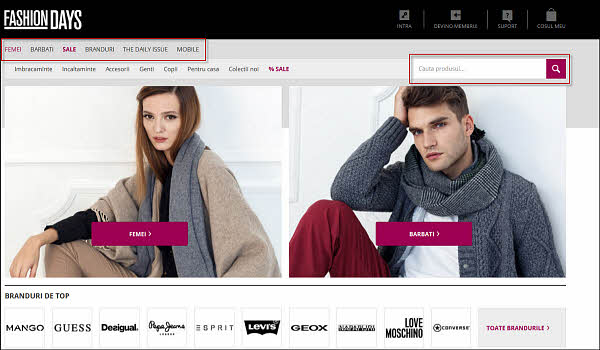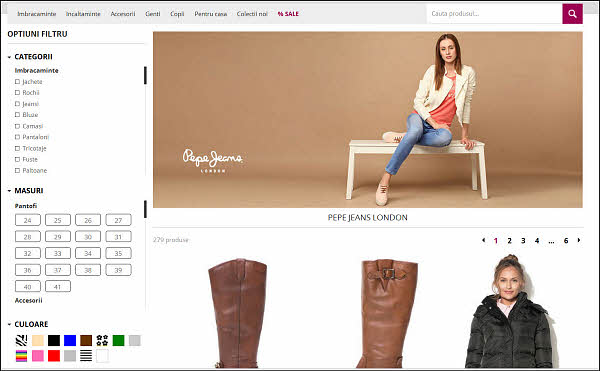by
Courtney Eckerle, Manager of Editorial Content
THE CUSTOMER
Fashion Days was established in June 2009 with the idea to bring top fashion brands and promote individual style in Central and Eastern Europe countries, according to Silviu Croitoru, Chief Product Officer, Fashion Days Group.
"The company quickly grew to become the number one fashion destination currently operating in Bulgaria, Hungary and Romania … We have more than five million customers and 1.6 million Facebook fans. With that, we have proven that we are the heart of the fashion community in the region," he said.
The typical Fashion Days customer is a woman between 24- and 34-years-old who is interested in fashion and clothing in general, he added.
CHALLENGE
Fashion Days started as a flash sale business, but over time, "we came to the conclusion we needed to switch from a flash sale to regular retail, meaning in-season products," Croitoru said.
The company came to that conclusion, he added, because "online retail is a much more sustainable business model. The main problem with a flash sale business model is that you have no control over the stock because actually you don't own the stock in-house."
He explained that in flash sales, companies keep a block of stock in a supplier’s warehouse, and delivery time is longer — sometimes taking up to a month.
"You can imagine that was frustrating for our customers. So in the end, we took our decision looking to improve our customer experience and at the same time generate business sustainability. That was the main reason we went from flash sales to regular retail," he said.
CAMPAIGN
In order to make this transition successfully, and improve customer experience, Fashion Days needed to focus on its operational aspects.
This meant speaking with new product suppliers, and ensuring that the sales platform was delivering "the features that today's shoppers expected. So that was the main thing we took [into] consideration when switching the big move — providing the features to our customers for the new business model," Croitoru said.
This was a big transition, he added, because a four-day flash sale might contain 100 products, and fostering navigation and browsing isn’t as critical.
"We had to start with the basics … We had to deliver navigation. We had to deliver sorting of products, recommendation, upsell, cross-sale and all these [features] customers expect on a retail shop," he said.
Step #1. Implement tools for basic functionality
This transition was discussed as early as 2012, Croitoru said, but in 2013 Fashion Days decided that the change needed to be made.
"We realized we needed to provide
new features and then we start looking to how we can implement these features in our sales channels," he said.

Click here to see the full version of this creative sample
First, he said, the team took into consideration building in-house tools for managing features in sales channels, but realized it would take too much time.
"We would not be able to make the transformation in the time we wanted. So we had to look into other tools — meaning third-party tools — [that] can help us to come up with these features," he said.
The team decided to use a tool that could work from different regions for translation purposes, he said, because, "first of all, it was covering all our needs. So they were able to provide filtering, navigation, search, product sorting, upsale, cross-sale widget and so on."
A second, but important aspect in the choice, was the ease of implementation for mobile ecommerce.
Step #2. Research comparable efforts
In understanding what features customers would be expecting as part of the experience, the team researched comparable companies, such as fashion ecommerce site Fab.com, which had made a similar transition.
"We looked at other websites, like big retail websites. At the time, we also did user research in our market to better understand the customer and better understand what they're expecting in this country from our online retail shop," Croitoru said.
They also augmented this with surveys, and research on smaller retail shops.
Step #3. Implement features into the system
During flash sales, Croitoru said, the inventory would be in the 50- to 100-item range, but currently "we are talking about between 5,000 and 10,000 products."
"You deal with a lot of product, we need to
take the customer to the right product. That's the main goal," he said.

Click here to see the full version of this creative sample
Once the team had decided on a tool and some of the basic features, they began fully implementing them into their system in order to properly manage it for retail.
"We made some rankings of the features, which ones we have to provide to our customers. We didn't want to come up with all of them at the same time because this business switch is quite risky," Croitoru said.
The first concern in customer groups, he said, is bargain hunters. Then, fashionistas who are searching for products that are current and available in online shops.
In order to serve these groups, and to minimize the risk, the team began introducing these features one by one.
"We started with filtering, then navigation, then search, sorting, upsell and cross-sell," he said, adding that the whole process took between a year and a year-and-a-half.
Besides implementing them, he said, the team had to optimize these features constantly, because "online, the shopping never ends" and there are always ways customer experience can be optimized.
Step #4. Weave customer data into the experience
From the Fashion Days’ team experience in flash sales, they had a lot of analytics about customer types and their correlating needs. When it comes to aspects like cross-selling, which is "an ongoing optimization," Croitoru said, this data can be useful.
"We are trying different things … it never stops. We are getting more and more data about customers. At the same time, we need to be able to apply and take advantage of data by using it in upsell and cross-sell as well," he added.
A lot of the data available to the team from when Fashion Days was using the flash sale model was helpful, but not all of it was relevant for a retail business, he added. It was important to understand what data was currently useful.
"They are two different buyers. In flash, it's more impulse buying. You see the product. You like it. It has a nice discount. You buy it. While on retail, it's about finding the product that you want because the customers are coming more or less knowing what they want to buy and it's less impulsive buying," he said.
In each implementation, he said, the team had a goal — a certain conversion rate, for example — and would constantly monitor for improvements based off of changes. The team reviewed eye maps, click maps and screen recordings to continue to mine useful data.
"We have thousands of screen recordings per month. So we are seeing our customers in action using the features we are talking about. We are having a lot of third-party tools that are tracking these implementations and changes," he said.
Listening to the customer and providing the expected experience is the basis of this transition, Croitoru said.
"Then of course we had to think incrementally … because it's quite risky. Our goal was to attract new in-season fashion shoppers, but we did not want to lose existing customers," he said.
By utilizing flash sale aspects and data, they were able to keep that alive for current customers, while new features for retail attracted new customers within the safety of a controlled process.
However these new features helped optimize customers' shopping experiences; they allow for consumers to search for products, either on desktop or mobile, as well as make the customer "drill down for more products with upsell and cross-sell. We have great results there as well. A lot of sales are coming from this switch. We provide [for] the customer as well. Besides these features, we also provide ways of expanding what they are looking for," he said.
RESULTS
Anecdotally, the team has seen "a lot of good feedback come from our customers. First of all, by changing the business type, we've managed to deliver the product much faster," Croitoru said.
The most important aspect of this transition, he added, was listening to the customer.
"Know exactly what they expect, know exactly what the business expects and put these together and come up with the strategy for making a turn or change in the business type or changing platforms," he said.
This transition is still ongoing, he added, and "never think you are finished because … when it comes to online and mobile business, you're never done. We don't see the transition to retail as one-off. Rather, we see it as a plan for continuous growth."
Some businesses are investing more on the business side, and some on the customer side, Croitoru said.
"In our case, we are using the user-centric approach. So in our case, the customer is really, really important," he said.
The results gained from that approach are:
- Time spent on site boosted by 50%
- Purchase conversion rates increased by 40%
- Doubled purchase conversion rates with product filtering
"We are really proud about these results in terms of time spent on the website because time spent on the website means more product page views, which translate into a better conversion rate overall," he said.
Creative Samples
- New site features
- Product options page
Sources
Fashion DaysSDLRelated Resources
MarketingSherpa Summit 2016 — At the Bellagio in Las Vegas, February 22-24
B2C Marketing: Site and search optimization leads to 15% increase in average order valueB2C Marketing: Senior living provider drives a 12% lift in online leads with questionnaire











